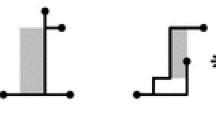Abstract
Let \(\mathcal{{T}}\) be a triangulation of a set \(\mathcal{{P}}\) of n points in the plane, and let e be an edge shared by two triangles in \(\mathcal{{T}}\) such that the quadrilateral Q formed by these two triangles is convex. A flip of e is the operation of replacing e by the other diagonal of Q to obtain a new triangulation of \(\mathcal{{P}}\) from \(\mathcal{{T}}\). The flip distance between two triangulations of \(\mathcal{{P}}\) is the minimum number of flips needed to transform one triangulation into the other. The Flip Distance problem asks if the flip distance between two given triangulations of \(\mathcal{{P}}\) is at most k, for some given \(k \in \mathbb {N}\). It is a fundamental and a challenging problem. We present an algorithm for the Flip Distance problem that runs in time \(\mathcal {O}(n + k \cdot c^{k})\), for a constant \(c \le 2 \cdot 14^{11}\), which implies that the problem is fixed-parameter tractable. We extend our results to triangulations of polygonal regions with holes, and to labeled triangulated graphs.







Similar content being viewed by others
Notes
If an action \(\sigma \) involves flipping an edge e, then \(\sigma \) is performed only when a flip of e is admissible.
References
Aichholzer, O., Alvarez, V., Hackl, T., Pilz, A., Speckmann, B., Vogtenhuber, B.: An improved lower bound on the minimum number of triangulations. In: 32nd International Symposium on Computational Geometry (SoCG 2016). Leibniz International Proceedings in Informatics, vol. 51, pp. 7:1–7:16. Leibniz-Zentrum fuer Informatik, Dagstuhl (2016)
Aichholzer, O., Hurtado, F., Noy, M.: A lower bound on the number of triangulations of planar point sets. Comput. Geom. 29(2), 135–145 (2004)
Aichholzer, O., Mulzer, W., Pilz, A.: Flip distance between triangulations of a simple polygon is NP-complete. Discrete Comput. Geom. 54(2), 368–389 (2015)
Bose, P., Hurtado, F.: Flips in planar graphs. Comput. Geom. 42(1), 60–80 (2009)
Brodal, G.S., Fagerberg, R.: Dynamic representation of sparse graphs. In: Dehne, F., et al. (eds.) Algorithms and Data Structures. Lecture Notes in Computer Science, vol. 1663, pp. 342–351. Springer, Berlin (1999)
Cleary, S., St. John, K.: Rotation distance is fixed-parameter tractable. Inf. Process. Lett. 109(16), 918–922 (2009)
Diestel, R.: Graph Theory. Graduate Texts in Mathematics. Springer, Heidelberg (2010)
Downey, R.G., Fellows, M.R.: Parameterized Complexity. Monographs in Computer Science. Springer, New York (1999)
Gao, Z., Urrutia, J., Wang, J.: Diagonal flips in labelled planar triangulations. Graphs Comb. 17(4), 647–657 (2001)
Hanke, S., Ottmann, T., Schuierer, S.: The edge-flipping distance of triangulations. J. UCS 2(8), 570–579 (1996)
Hopcroft, J., Tarjan, R.: Efficient planarity testing. J. Assoc. Comput. Mach. 21(4), 549–568 (1974)
Hopcroft, J.E., Wong, J.K.: Linear time algorithm for isomorphism of planar graphs. In: Book, R.V., et al. (eds.) Sixth Annual ACM Symposium on Theory of Computing, pp. 172–184. Association for Computing Machinery, New York (1974)
Hurtado, F., Noy, M., Urrutia, J.: Flipping edges in triangulations. Discrete Comput. Geom. 22(3), 333–346 (1999)
Kanj, I., Xia, G.: Flip distance is in \(FPT\) Time \({\cal{O}}(n+ k \cdot c^k)\). In: Mayr, E.W., Ollinger, N. (eds.) 32nd International Symposium on Theoretical Aspects of Computer Science. Leibniz International Proceedings in Informatics, vol. 30, pp. 500–512. Leibniz-Zentrum fuer Informatik, Dagstuhl (2015)
Kocay, W., Kreher, D.L.: Graphs, Algorithms, and Optimization. Discrete Mathematics and Its Applications, 2nd edn. CRC Press, Boca Raton (2017)
Lawson, C.L.: Transforming triangulations. Discrete Math. 3(4), 365–372 (1972)
De Loera, J.A., Rambau, J., Santos, F.: Triangulations: Structures for Algorithms and Applications. Algorithms and Computation in Mathematics, vol. 25. Springer, Berlin (2010)
Lubiw, A., Pathak, V.: Flip distance between two triangulations of a point set is NP-complete. Comput. Geom. 49, 17–23 (2015)
Lucas, J.M.: An improved kernel size for rotation distance in binary trees. Inf. Process. Lett. 110(12–13), 481–484 (2010)
Mori, R., Nakamoto, A., Ota, K.: Diagonal flips in Hamiltonian triangulations on the sphere. Graphs Comb. 19(3), 413–418 (2003)
Mouawad, A.E., Nishimura, N., Raman, V.: Vertex cover reconfiguration and beyond. In: Ahn, H.-K., et al. (eds.) Algorithms and Computation. Lecture Notes in Computer Science, vol. 8889, pp. 452–463. Springer, Cham (2014)
Mouawad, A.E., Nishimura, N., Raman, V., Simjour, N., Suzuki, A.: On the parameterized complexity of reconfiguration problems. In: Gutin, G., Szeider, S. (eds.) Parameterized and Exact Computation. Lecture Notes in Computer Science, vol. 8246, pp. 281–294. Springer, Cham (2013)
Mouawad, A.E., Nishimura, N., Raman, V., Wrochna, M.: Reconfiguration over tree decompositions. In: Cygan, M., Heggernes, P. (eds.) Parameterized and Exact computation. Lecture Notes in Computer Science, vol. 8894, pp. 246–257. Springer, Cham (2014)
Niedermeier, R.: Invitation to Fixed-Parameter Algorithms. Oxford Lecture Series in Mathematics and Its Applications, vol. 31. Oxford University Press, Oxford (2006)
Okabe, A., Boots, B., Sugihara, K.: Spatial Tessellations: Concepts and Applications of Voronoĭ Diagrams. Applied Probability and Statistics. Wiley Series in Probability and Mathematical Statistics, Wiley, Chichester (1992)
Pilz, A.: Flip distance between triangulations of a planar point set is APX-hard. Comput. Geom. 47(5), 589–604 (2014)
Saalfeld, A.: Joint triangulations and triangulation maps. In: CG87 Third Annual Symposium on Computational Geometry, pp. 195–204. Association for Computing Machinery, New York (1987)
Schumaker, L.L.: Triangulations in CAGD. IEEE Comput. Graph. Appl. 13(1), 47–52 (1993)
Sibson, R.: Locally equiangular triangulations. Comput. J. 21(3), 243–245 (1978)
Sleator, D.D., Tarjan, R.E., Thurston, W.P.: Rotation distance, triangulations, and hyperbolic geometry. J. Am. Math. Soc. 1(3), 647–681 (1988)
Sleator, D.D., Tarjan, R.E., Thurston, W.P.: Short encodings of evolving structures. SIAM J. Discrete Math. 5(3), 428–450 (1992)
Wagner, K.: Bemerkungen zum Vierfarbenproblem. Jahresber. Dtsch. Math.-Ver. 46, 26–32 (1936)
Watson, D.F., Philip, G.M.: Systematic triangulations. Comput. Vis. Graph. Image Process. 22(2), 310 (1983)
Author information
Authors and Affiliations
Corresponding author
Additional information
Editor in Charge: Günter M. Ziegler
An extended abstract of this work (without the complete proofs and the extension to labeled triangulated graphs) appears in [14].
Rights and permissions
About this article
Cite this article
Kanj, I., Sedgwick, E. & Xia, G. Computing the Flip Distance Between Triangulations. Discrete Comput Geom 58, 313–344 (2017). https://doi.org/10.1007/s00454-017-9867-x
Received:
Revised:
Accepted:
Published:
Issue Date:
DOI: https://doi.org/10.1007/s00454-017-9867-x




